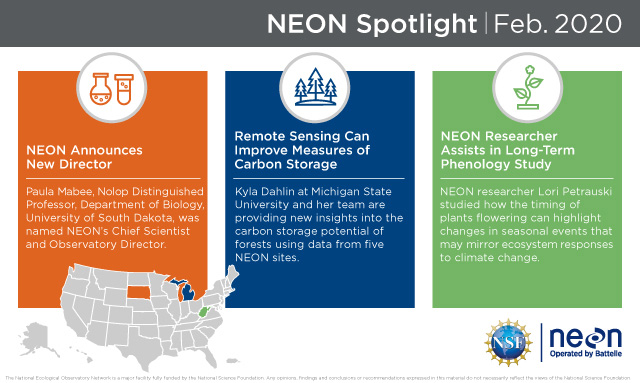What’s New With NEON?

This Month’s Spotlight
The latest news from the NEON project includes:-
Paula Mabee was named Chief Scientist and Observatory Director of NEON. Mabee is the Nolop Distinguished Professor in the Department of Biology at the University of South Dakota. From 2015 to 2017 she served as Division Director for the Division of Environmental Biology in the Directorate of Biological Sciences with the National Science Foundation. Author of over 60 research publications and AAAS Fellow, Mabee is an outstanding leader in the field of biology, and NEON is honored to have her at the helm of the project.
-
Kyla Dahlin, an Assistant Professor in the Michigan State University (MSU) Department of Geography, Environment, and Spatial Sciences, is working with her team to use Airborne Remote Sensing data from five NEON sites, with the goal of developing detailed 3D maps of forest structure. Forests play an important role in absorbing atmospheric CO2, and by estimating vegetation and photosynthetic capacity on a large scale, this research can shed light on the carbon storage potential of forests.
-
Lori Petrauski, field ecologist with NEON, participated in a study of plant phenology, or seasonal events such as flowering, with a team of scientists focused on wildflowers native to the eastern US. The findings, published in Plant Ecology, were not part of NEON itself, but studying the shifts in flowering time and potential pollinator mismatches is a crucial piece of information to understand changing ecosystems. Petrauski’s work demonstrates how NEON researchers are expanding our knowledge of ecosystem changes in important ways.
By enabling scientists, researchers and students to address critical questions and understand ecosystem changes over time, the NEON project allows the ecological community to tackle questions and problems at a scale that wasn’t possible before. Sponsored by the National Science Foundation (NSF) and operated by Battelle, NEON is a continental-scale ecological observatory facility dedicated to providing high-quality, consistently generated data that is free and available to all users.
You can read about the latest research in the NEON Spotlight every month at Inside Battelle, and also on our social media channels. For more information about NEON, visit NEONscience.org.
BATTELLE UPDATES
Receive updates from Battelle for an all-access pass to the incredible work of Battelle researchers.